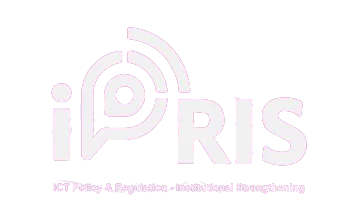[et_pb_section fb_built="1" admin_label="section" _builder_version="4.16" global_colors_info="{}"][et_pb_row admin_label="row" _builder_version="4.16" background_size="initial" background_position="top_left" background_repeat="repeat" global_colors_info="{}"][et_pb_column type="4_4" _builder_version="4.16" custom_padding="|||" global_colors_info="{}" custom_padding__hover="|||"][et_pb_code _builder_version="4.23.1" _module_preset="default" global_colors_info="{}"][/et_pb_code][et_pb_text admin_label="Text" _builder_version="4.16" background_size="initial" background_position="top_left" background_repeat="repeat" global_colors_info="{}"]
Alexandra Högberg from SPIDER Center interviewed Lwando Bbuku - Manager, Markets and Competition, Zambia Information and Communications Technology Authority (ZICTA), along the sidelines of the Sweden 2023 phase. In this interview, Lwando Bbuku weighs in on digital inclusion.
This interview has been edited for clarity and readability.
Lwando Bbuku: My name is Lwando Bbuku with the Zambia information and communications technology authority. I represent the department responsible for economic regulation and consumer protection.
AH: How can regulators contribute to the advancement of the ICT sector in Africa?
LB: Looking at the era we're in today of digital transformation and digital adoption, I think African regulators need to come together and collaborate a lot more effectively if we're to address the challenges of an advancing economy and moving into a digital society. What we see as a big challenge obviously comes along in the form of the internationalisation of services, we have digital platforms that are no longer respecters of borders, and that essentially require a concerted and coordinated efforts to address a lot of the topical issues. So if we're looking at issues around consumer protection, if we're looking at issues around economic regulation, and competition management, all those in a digital era, literally do not respect boundaries of traditional relevant markets and delineations of different geographical borders. So we need to do a lot more in form of international collaboration, working both at regional level and at the international level, and I think the SPIDER program really gives us a good platform to basically extend and leverage of those linkages that we have across the different countries. So I would say Key among the issues that we need to do to advance the Digital Agenda Africa, is to really collaborate and coordinate with a common purpose and basically see that we take our space in the digital age.
AH: What specific challenges does your country/region face in the current global telecommunication landscape? And how will you change initiative addresses this?
LB: From a Zambian perspective, we've seen significant amount of investment into infrastructure, we've been working quite extensively towards bridging the coverage gap, we deployed communication towers, we've deployed fiber infrastructure backbone, and we're still working quite significantly towards last mile connectivity. But the big challenge that we see is the fact that we have an extensive and ever-growing usage gap. So while we're closing the coverage gap, we still we still see that people are not actually adopting these digital services, and one of the challenges that comes from is the fact that we do not necessarily have equitable access to services, and we do not have equitable access to infrastructure. While we have deployed significantly in urban areas, we still have a very big digital divide in terms of the urban rural divide.
We've seen that from an infrastructure perspective, while we do have the underlying backbones, and the majority of our population actually live within the footprint of a communication signal, they've had barriers to access ranging from affordability of devices, they've had barriers to access, ranging from digital literacy and skills, and those are critical challenges that we're trying to address as a regulator. So key among our efforts now is to really ensure that we set the tone from a foundational perspective. So we're, we're essentially actively working towards ensuring that we have the right amount of digital infrastructure spread out across the country as effectively as possible. So we see that investments might be duplicated in some cases, and what we're trying to adjust for that change initiative is essentially to make sure that where there's existing infrastructure, let's get the utilisation of that particular infrastructure up.
Why we say that is because it doesn't make sense for us to have two or three lines of fiber passing through the same area where we could easily consolidate into one and channel the additional investments into areas that have traditionally been marginalised and left aside. What our change initiative basically aims to do is to allow us to create a regime and a framework that will incentivise and promote infrastructure sharing. Why we think that's very important is that the digital infrastructure is the foundational pillar of digital transformation. Once we get to a point that we're able to have effective usage and sharing of infrastructure, we then expect to see an increase in the usage and uptake of services, and this is coming from a supply side because we want to make basically make sure that we have more providers, offering innovative services on the market. So that lowers the barriers to entry if we have an equitable framework for sharing of existing infrastructure, and we could then bring in a lot more service-based competition into the market.
So while we have our underlying infrastructure available, we then expect to see an increase in the number of additional players that come on to the market and offer specific and new innovative services that will address a lot of the challenges around inclusivity. So what we love to see as essentially coming from a place where we have the traditional big network and infrastructure providers have been deployed quite significantly, but we're looking at ways to basically optimise the utilisation of existing infrastructure, and that will then drive innovation, and also drive additional penetration and adoption of services.
AH: Any other highlight that you want to add?
LB: So, from the perspective of what we've been able to go through over the last two weeks, I think we've built up a quite robust framework for how we could go about implementing a change initiative. And I think that stems from the extensive focus on the project management methodology. And starting from an impact perspective, I think we see in a lot more broader sense, what we actually are trying to achieve and for us, that specifically aims at improving digital adoption and usage of digital services. So we're tackling it for tackling it from a foundational perspective, and we basically start from a project perspective, looking at what do we intend to achieve, we intend to achieve the fact that we have inclusive and accessible digital services that the majority of Zambians can benefit from, and effectively contribute to our digital transformation agenda.
From an outcome perspective, we basically are looking at ensuring that we lower barriers to entry in the market, and we have an increase in the number of players that can actually participate at a service level. So we're looking at basically streamlining the investment process, lowering the barriers so that new players efficiently roll out their networks, rather roll out their services, and reach more people, and that basically will see us move from a position of having approximately only 25 or so percent of people actually accessing the internet, to hopefully push that towards 50 and 60%. In the medium to short term.
I think that basically will come from the fact that once we have efficient infrastructure sharing, we have more players that are able to now provide fiber to the home services or fixed wireless access services, targeting specific communities that are within the reach of existing infrastructure, but just haven't had the incentive for new players to come on the market, and tap into some of those services. So from that perspective, we basically hope that we can achieve a much broader sort of inclusivity approach towards our rollouts, and our coverage obligations that we set out for our respective licensees. So once we have a framework in place that basically caters to new and emerging types of infrastructure sharing, access things like open access, active sharing, things such as mobile virtual network operators, we think we can then start to target more specific segments of society, be it in a rural setup, be it in a underprivileged school, for instance, that requires a specific private network setup.
Once we have facilities in place to basically facilitate that sort of more designated specific sort of sharing, we then expect to see a much more inclusive approach towards rollout of infrastructure, as well as to the adoption of digital services. The first output that we're looking at developing and delivering from this project will be the revision of our regulatory framework that basically caters for infrastructure sharing, and wholesale access. We believe that by creating this forward looking and responsive regime, we can then address and create the foundation for all the outcomes and impact that we hope to achieve.
The second phase of our project will see us move into a more transparency related focus of the project, and that's where we hope to see the development and deployment of systems and tools that will facilitate the coordination and approval process of infrastructure deployment. We basically hope to learn and leverage of some of the experiences we've had here with the Lebanon, Scotland, for instance, and see that we can implement a similar platform in phase two, which will obviously be in the subsequent months, probably the next year or two. And what we're doing now is laying the foundation for that and allowing for us to move forward in that space.
AH: Is there a specific memory that will stay with you from this very first round of iPRIS 2023?
LB: From a involvement perspective, I think we visited Ericsson. For me, it was quite an inspiring activity that we undertook, the sessions that we had with the team over at Ericsson, were really eye opening and insightful. I think the fact that the company has been in existence for so long basically demonstrates its commitment towards basically digital everything and digital transformation, and facilitation.
I was quite intrigued, actually, by the session that basically looked at the future, and where we're going and how much further we still have to go on the development of technology and the different advancements that are possible. So from a connectivity perspective, I think that they really hit home hard, because I realized that we as a regulator, have a very important role to play in basically making sure that we do not stifle innovation in the way that we regulate, and basically make sure that we enable a lot of the developments that are still yet to come. And I mean, countries in Africa, like we saw are still very far off on the 5G adoption map.
So we think that we need to do a lot more to incentivize the rollout of additional advancements in technology, but also to make sure that our people are not left behind. Because that's primarily a big challenge that we face is that while we may have access to the technology, our people have not equally been upgraded in terms of their digital skills, and literacy levels to basically enjoy and reap the benefits of such technology. So I'm quite excited about that, and I'll take that home as a lesson learned and changing my thinking to be more open and forward looking in terms of what's yet to come in the future.
AH: Anything else you want to add?
LB: Final thoughts for me are really the key takeaway is that the change initiative that based on the model that I present, SPIDER has rolled out for this kind of change initiative, I think is a very innovative approach to addressing a lot of our challenges. It moves us away from theoretical kinds of capacity building, and takes us to a more hands on and practical and impactful sort of way of doing things. So I'm quite keen to see our change initiative executed. And I'm quite keen to see the impacts and outcomes start to roll out even beyond my time and sector and I'll be happy to look back in a few years and say that this was something that I specifically championed and spearheaded and look forward to seeing positive outcomes from that.
[/et_pb_text][/et_pb_column][/et_pb_row][/et_pb_section]





